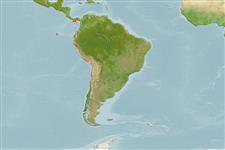Common names from other countries
>
Blenniiformes (Blennies) >
Blenniidae (Combtooth blennies) > Salariinae
Etymology: Scartichthys: Greek, skaritis, -idos = a jewel stone with the colour of the fish scarus (Ref. 45335); gigas: Latin, gigas = giant; refers to the relatively large size of adults (Ref. 10696).
More on author: Steindachner.
Environment: milieu / climate zone / depth range / distribution range
นิเวศวิทยา
เกี่ยวกับทะเล,น้ำเค็ม สัตว์น้ำหน้าดิน; ระดับความลึก 0 - 10 m. Tropical; 9°N -
Eastern Pacific: Panama (Ref. 9280) to northern Chile (Ref. 10696).
ขนาด / น้ำหนัก / Age
Maturity: Lm ? range ? - 13 cm
Max length : 25.1 cm TL เพศผู้/กระเทย; (Ref. 122662)
Short description
เครื่องมือที่ใช้ในการแยกชนิดสัตว์,สิ่งมีชีวิตออกจากกัน | สัณฐานวิทยา | ความยาวต่างๆ
เงี่ยงครีบหลัง (รวม) : 11 - 13; ก้านครีบอ่อนที่หาง (รวม) : 16 - 18; เงี่ยงครีบก้น: 2; ก้านครีบอ่อนที่ก้น: 18 - 20. With fewer than 70 dentary incisors and a reticulated color pattern.
Adults inhabit rocky coasts (Ref. 9280). They feed on plants, small mollusks and crustaceans (Ref. 9280). Oviparous (Ref. 205). Eggs are deposited in mollusk shells or on rocks (Ref. 9280). Larvae are planktonic, often found in shallow, coastal waters (Ref. 94114). Used to prepare a soup called 'borracho' which evokes slight intoxication and tiredness; these effects, however, are of short duration (Ref. 9280).
Oviparous, distinct pairing (Ref. 205).
Hastings, P.A., 1995. Blenniidae. Borrachos. p. 927-930. In W. Fischer, F. Krupp, W. Schneider, C. Sommer, K.E. Carpenter and V. Niem (eds.) Guia FAO para Identification de Especies para lo Fines de la Pesca. Pacifico Centro-Oriental. 3 Vols. FAO, Rome. (Ref. 9280)
IUCN Red List Status (Ref. 130435)
CITES (Ref. 128078)
Not Evaluated
Human uses
การประมง: มีการค้าเพียงเล็กน้อย
เครื่องมือ
Special reports
Download XML
แหล่งที่มาจากอินเตอร์เน็ต
Estimates based on models
Preferred temperature (Ref.
115969): 18.1 - 26.8, mean 20.5 (based on 113 cells).
Phylogenetic diversity index (Ref.
82804): PD
50 = 0.5625 [Uniqueness, from 0.5 = low to 2.0 = high].
Bayesian length-weight: a=0.00813 (0.00434 - 0.01522), b=3.02 (2.85 - 3.19), in cm Total Length, based on LWR estimates for this species & (Sub)family-body (Ref.
93245).
ระดับชั้นอาหาร (Ref.
69278): 3.0 ±0.39 se; based on food items.
ความสามารถในการกลับคืนสู่ปกติ (Ref.
120179): ขนาดกลาง, เวลาต่ำสุดที่จะทำให้ประชากรเพิ่มขึ้นเป็น 2 เท่าใช้เวลา 1.4 - 4.4 ปี (Assuming tm=1 and Fec=100-1000).
Fishing Vulnerability (Ref.
59153): Low vulnerability (15 of 100).
